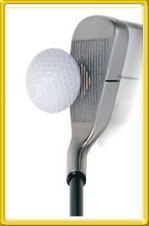
In golf, the term “Coefficient of Restitution” (COR), also known as “Characteristic Time” (CT), refers to the measurement of the spring-like effect or the trampoline effect of a golf club face. It quantifies how much energy is transferred from the club face to the golf ball upon impact.
Here are a few key points about the Coefficient of Restitution (COR) of a golf club:
- Measurement: The COR of a golf club is determined by measuring the speed of the golf ball before and after impact with the club face. The COR value is calculated as the ratio of the final velocity to the initial velocity of the ball.
- Limits and Regulations: Golf's governing bodies, such as the United States Golf Association (USGA) and the R&A, set limits on the maximum COR value allowed for golf club faces used in competition. These limits are in place to maintain fairness, control the distance potential of the golf clubs, and ensure a balance between skill and technology. Currently, the USGA limits the COR value for driver club faces to 0.830.
- Effect on Distance: The COR value of a golf club face directly affects the ball's initial velocity and, consequently, the distance it can travel. A higher COR value indicates a more elastic club face, which allows for more energy transfer to the ball, resulting in increased ball speed and distance. However, it's important to note that other factors such as clubhead speed, launch angle, and strike quality also influence the overall distance achieved.
- Driver Considerations: The COR value of a driver club face is particularly important because drivers are designed to maximize distance off the tee. Golfers often seek drivers with high COR values to optimize their potential for long drives. However, it's crucial to adhere to the COR limits set by golf's governing bodies for sanctioned play.
- Variations in COR: Different clubs within a golfer's bag, such as irons, wedges, and putters, may have different COR values. Manufacturers often design clubs with specific COR values to optimize performance characteristics for each club type. For example, irons may have lower COR values to enhance control and accuracy, while drivers prioritize higher COR values for distance.
Understanding the Coefficient of Restitution (COR) of golf club faces can help golfers make informed decisions about their equipment selection. It's essential to consider the COR value along with other factors such as clubhead speed, launch conditions, and personal preferences to find the clubs that suit their game and desired performance outcomes.
A measurement of how much energy is lost or retained in a collision between two objects, such as a golf ball and clubface. Coefficient of Restitution (COR) may be anywhere between 0.000 (no energy transferred) and 1.000 (all energy transferred).
The COR of golf clubheads is limited to 0.83, meaning 83 percent of energy is transferred from club to ball at impact.





